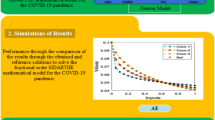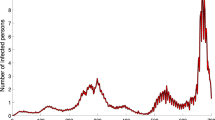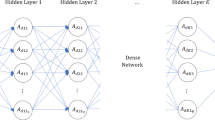Abstract
Over the past two decades, avian influenza viruses have rapidly spread in poultry around the world. Both humans and industrial poultry are at risk from avian influenza virus infection because of their high levels of zoonotic transmission and pandemic potential. The goal of this study is to explore the implementation of a soft computing paradigm that incorporates artificial intelligence to numerically solve delayed-differential systems which portray the dynamical interfaces of a nonlinear delayed avian influenza (DAI-EM) employing a backpropagated Bayesian regularization neural network (BBR-NN) approach. The nonlinear DAI-EM is represented by the four classes: susceptible avian, infected avian, susceptible human and infected human populations. The Adams solver is utilized to construct the benchmark dataset for BBR-NN for the variability in the transmission rate between infected and susceptible avian, avian population natural mortality rate, avian population diseases associated mortality rate, rate of avian slaughter in the susceptible population, rate of avian slaughter in the infected population, transmission rate between infected avian and susceptible human, human population natural mortality rate, infective human population diseases associated mortality rate, infective human population recovery rate. The designed BBR-NN determined the numerical approximate solutions of the DAI-EM by arbitrarily choosing training, testing and validation sample points from the dataset and yielded promising agreements to the benchmark results. The competency, accuracy, and consistency of the design BBR-NN are assessed/evaluated further using a comprehensive simulation study that incorporates mean square error, error histogram, and regression analysis.






























Similar content being viewed by others
Data availability statement
This paper is not associated with any data.
Abbreviations
- DAI:
-
Delayed avian influenza
- BBR-NN:
-
Backpropagated Bayesian regularization neural network
- ODEs:
-
Ordinary differential equations
- AIV:
-
Avian influenza viruses
- SVEIR:
-
Susceptible-vaccinated-exposed class-infected class-removed
- AI:
-
Artificial intelligence
- ADS:
-
Adams numerical solver
- S v(t), I v(t), S m(t), I m(t), and R m(t):
-
Susceptible avian-infective avian-susceptible human-infective human-removed human
- S v(0), I v(0), S m(0), I m(0), and R m(0):
-
Initial values of susceptible avian-infective avian-susceptible human-infective human-removed human
- AE:
-
Absolute error
- GUI:
-
Graphical user interface
- \(\Lambda_{v}\) :
-
Births and new recruits in avian populations
- \(\alpha_{v}\) :
-
Transmission rate between infected and susceptible avian
- \(\omega_{v}\) :
-
Avian population natural mortality rate
- \(\eta_{v}\) :
-
Avian population diseases associated mortality rate
- \(\eta_{1}\) :
-
Rate of avian slaughter in the susceptible population
- \(\eta_{2}\) :
-
Rate of avian slaughter in the infected population
- \(\Lambda_{m}\) :
-
Births and new recruits in avian populations
- \(\alpha_{m}\) :
-
Transmission rate between infected avian and susceptible human
- \(\omega_{m}\) :
-
Human population natural mortality rate
- \(\eta_{m}\) :
-
Infective human population diseases associated mortality rate
- \(\beta\) :
-
Infective human population recovery rate
- \(\delta_{1}\) :
-
Time lag for avian incubation period
- \(\delta_{2}\) :
-
Time lag for human incubation period
References
J. Huang, K. Li, S. Xiao, J. Hu, Y. Yin, J. Zhang, S. Li, W. Wang, J. Hong, Z. Zhao, X. Chen, Global epidemiology of animal influenza infections with explicit virus subtypes until 2016: A spatio-temporal descriptive analysis. One Health 16, 100514 (2023)
Y. Sun, T. Zhang, X. Zhao, J. Qian, M. Jiang, M. Jia, Y. Xu, W. Yang, L. Feng, High activity levels of avian influenza upwards 2018–2022: a global epidemiological overview of fowl and human infections. One Health 16, 100511 (2023)
K.F. Shortridge, N.N. Zhou, Y. Guan, P. Gao, T. Ito, Y. Kawaoka, S. Kodihalli, S. Krauss, D. Markwell, K.G. Murti, M. Norwood, Characterization of avian H5N1 influenza viruses from poultry in Hong Kong. Virology 252(2), 331–342 (1998)
L.D. Sims, T.M. Ellis, K.K. Liu, K. Dyrting, H. Wong, M. Peiris, Y. Guan, K.F. Shortridge, Avian influenza in Hong Kong 1997–2002. Avian Dis. 47(s3), 832–838 (2003)
W.O. Kermack, A.G. McKendrick, Contributions to the mathematical theory of epidemics–I. 1927. Bull. Math. Biol. 53(1–2), 33–55 (1991)
Y. Zhao, L. Zhang, S. Yuan, The effect of media coverage on threshold dynamics for a stochastic SIS epidemic model. Phys. A 512, 248–260 (2018)
M. Perc, N. Gorišek Miksić, M. Slavinec, A. Stožer, Forecasting covid-19. Front. Phys. 8, 127 (2020)
M. Jusup, P. Holme, K. Kanazawa, M. Takayasu, I. Romić, Z. Wang, S. Geček, T. Lipić, B. Podobnik, L. Wang, W. Luo, Social physics. Phys. Rep. 948, 1–148 (2022)
M. Naveed, A. Raza, A.H. Soori, M. Inc, M. Rafiq, N. Ahmed, M.S. Iqbal, A dynamical study of diarrhea delayed epidemic model: application of mathematical biology in infectious diseases. Eur. Phys. J. Plus 138(7), 664 (2023)
S.M. Malakouti, Heart disease classification based on ECG using machine learning models. Biomed. Signal Process. Control 84, 104796 (2023)
J. Hu, Z. Teng, Z. Li, B. Wen, The threshold dynamics in a stochastic SIS epidemic model with vaccination and nonlinear incidence under regime switching. Phys. A 529, 121555 (2019)
P. Srinivas, R. Katarya, hyOPTXg: OPTUNA hyper-parameter optimization framework for predicting cardiovascular disease using XGBoost. Biomed. Signal Process. Control 73, 103456 (2022)
M.A. Khan, S. Ullah, Y. Khan, M. Farhan, Modeling and scientific computing for the transmission dynamics of avian influenza with half-saturated incidence. Int. J. Model. Simul. Sci. Comput. 11(04), 2050035 (2020)
C. Tadmon, B. Tsanou, A.F. Feukouo, Avian–human influenza epidemic model with diffusion, nonlocal delay and spatial homogeneous environment. Nonlinear Anal. Real World Appl. 67, 103615 (2022)
Y. Chen, Z. Jin, J. Zhang, Y. Wang, J. Zhang, Global dynamical analysis of H5 subtype avian influenza model. Int. J. Biomath. 15(08), 2250058 (2022)
X. Jiang, Y. Yu, F. Meng, Y. Xu, Modelling the dynamics of avian influenza with nonlinear recovery rate and psychological effect. J. Appl. Anal. Comput. 10(3), 1170–1192 (2020)
G. Baggio, F. Filippini, I. Righetto, Comparative surface electrostatics and normal mode analysis of high and low pathogenic H7N7 Avian influenza viruses. Viruses 15(2), 305 (2023)
X.T. Xie, A. Yitbarek, S.U. Khan, S. Sharif, Z. Poljak, A.L. Greer, A within-host mathematical model of H9N2 avian influenza infection and type-I interferon response pathways in chickens. J. Theor. Biol. 499, 110320 (2020)
A. Feukouo Fossi, J. Lubuma, C. Tadmon, B. Tsanou, Mathematical modeling and nonstandard finite difference scheme analysis for the environmental and spillover transmissions of Avian Influenza A model. Dyn. Syst. 36(2), 212–255 (2021)
A. Andronico, A. Courcoul, A. Bronner, A. Scoizec, S. Lebouquin-Leneveu, C. Guinat, M.C. Paul, B. Durand, S. Cauchemez, Highly pathogenic avian influenza H5N8 in south-west France 2016–2017: a modeling study of control strategies. Epidemics 28, 100340 (2019)
C. Modnak, J. Wang, An avian influenza model with latency and vaccination. Dyn. Syst. 34(2), 195–217 (2019)
R. Zhang, N. Li, X. Wang, B. Liu, F. Li, S. Zhang, X. Zhang, Z. Wang, Spatial analysis and mathematical modeling of human infection with avian influenza A (H7N9) virus in Zhejiang 2013–2016. Dis. Surveill. 34(1), 15–20 (2019)
A.C. Emmanuel, I.M. Olanrewaju, Mathematical modelling of the stability of highly pathogenic avian influenza with saturated contact rate. J. Math. Sci. Comput. Math. 2(2), 266–286 (2021)
T. Kang, Q. Zhang, L. Rong, A delayed avian influenza model with avian slaughter: Stability analysis and optimal control. Physica A 529, 121544 (2019)
W.A. Lodwick, E.A. Untiedt, Fuzzy optimization, in Granular, Fuzzy, and Soft Computing, (Springer, New York, 2023), pp. 755–791
Z. Li, J. Wang, J. Huang, M. Ding, Development and research of triangle-filter convolution neural network for fuel reloading optimization of block-type HTGRs. Appl. Soft Comput. 136, 110126 (2023)
N. Anwar et al., Artificial intelligence knacks-based stochastic paradigm to study the dynamics of plant virus propagation model with impact of seasonality and delays. Eur. Phys. J. Plus 137(1), 1–47 (2022)
M. Shoaib et al., Intelligent networks knacks for numerical treatment of nonlinear multi-delays SVEIR epidemic systems with vaccination. Int. J. Modern Phys. B 36, 2250100 (2022)
A. Mehmood et al., Fuzzy-weighted differential evolution computing paradigm for fractional order nonlinear wiener systems. Chaos Solit. Fract. 159, 112160 (2022)
N. Anwar et al., Intelligent computing networks for nonlinear influenza-A epidemic model. Int. J. Biomath. 16(04), 2250097 (2023)
M. Shoaib et al., Neuro-computational intelligence for numerical treatment of multiple delays SEIR model of worms propagation in wireless sensor networks. Biomed. Signal Process. Control 84, 104797 (2023)
Z. Khan, S. Zuhra, S. Islam, M.A.Z. Raja, A. Ali, Modeling and simulation of Maxwell nanofluid flows in the presence of Lorentz and Darcy-Forchheimer forces: toward a new approach on Buongiorno’s model using artificial neural network (ANN). Eur. Phys. J. Plus 138(1), 107 (2023)
M. Shoaib, S. Naz, K.S. Nisar, M.A.Z. Raja, S. Aslam, I. Ahmad, MHD casson nanofluid in darcy-forchheimer porous medium in the presence of heat source and Arrhenious activation energy: applications of neural networks. Int. J. Model. Simul. 43(4), 438–461 (2023)
Z. Shi, X. Zhang, D. Jiang, Dynamics of an avian influenza model with half-saturated incidence. Appl. Math. Comput. 355, 399–416 (2019)
X. Wei, L. Wang, Q. Jia, J. Xiao, G. Zhu, Assessing different interventions against Avian Influenza A (H7N9) infection by an epidemiological model. One Health 13, 100312 (2021)
Y. Chen, H. Zhang, J. Wang, C. Li, N. Yi, Y. Wen, Analyzing an epidemic of human infections with two strains of zoonotic virus. Mathematics 10(7), 1037 (2022)
M.F. Malik et al., Swarming intelligence heuristics for fractional nonlinear autoregressive exogenous noise systems. Chaos Solit. Fract. 167, 113085 (2023)
O.F. Benaouda, S. Kahla et al., Integration of reconfigurable fault-tolerant three-level inverter in photovoltaic power system. Int. J. Model. Simul. (2023). https://doi.org/10.1080/02286203.2023.2165786
F. Almeida, M.L. Keerthi, B.J. Gireesha, P. Venkatesh, P. Kumar, B. Nagaraja, Consistent ramifications of prescribed surface temperature and prescribed heat flux boundary conditions for the slip flow of Walter B fluid in a stretching channel. Int. J. Model. Simul. (2023). https://doi.org/10.1080/02286203.2023.2237845
G.C. Wu, J.L. Wei, C. Luo, L.L. Huang, Parameter estimation of fractional uncertain differential equations via Adams method. Nonlinear Anal. Model. Control 27(3), 413–427 (2022)
E. Kantar, M. Ertaş, Dynamic study of a ternary trilayer Ising system with crystal field interaction. Eur. Phys. J. Plus 138(6), 509 (2023)
D. Baleanu, P. Shekari, L. Torkzadeh, H. Ranjbar, A. Jajarmi, K. Nouri, Stability analysis and system properties of Nipah virus transmission: a fractional calculus case study. Chaos Solit. Fract. 166, 112990 (2023)
G.D. Varsamis, I.G. Karafyllidis, G.C. Sirakoulis, Quantum walks in spaces with applied potentials. Eur. Phys. J. Plus 138(4), 1–10 (2023)
T.N.T. Minh, V.H. Le, N.Q.K. Le, Diffusion-tensor imaging and dynamic susceptibility contrast MRIs improve radiomics-based machine learning model of MGMT promoter methylation status in glioblastomas. Biomed. Signal Process. Control 86, 105122 (2023)
T. Makayssi, M. Lamsaadi, M. Kaddiri, Y. Tizakast, Effect of an ascendant magnetic field on Rayleigh-Bénard convection for non-Newtonian power-law fluids in a horizontal rectangular cavity submitted to vertical temperature gradient. Eur. Phys. J. Plus 138(7), 650 (2023)
Author information
Authors and Affiliations
Corresponding author
Ethics declarations
Conflict of interest
No conflict of interest, according to all of the manuscript's authors.
Rights and permissions
Springer Nature or its licensor (e.g. a society or other partner) holds exclusive rights to this article under a publishing agreement with the author(s) or other rightsholder(s); author self-archiving of the accepted manuscript version of this article is solely governed by the terms of such publishing agreement and applicable law.
About this article
Cite this article
Anwar, N., Ahmad, I., Fatima, A. et al. Design of intelligent Bayesian supervised predictive networks for nonlinear delay differential systems of avian influenza model. Eur. Phys. J. Plus 138, 911 (2023). https://doi.org/10.1140/epjp/s13360-023-04533-w
Received:
Accepted:
Published:
DOI: https://doi.org/10.1140/epjp/s13360-023-04533-w




